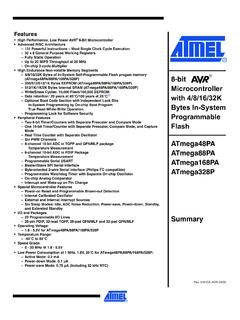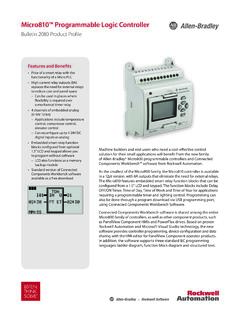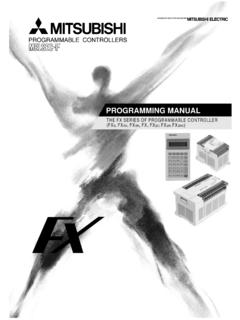Transcription of ATmega328P - Microchip Technology
1 7810D-AVR-01/15 Features High performance, low power AVR 8-bit microcontroller Advanced RISC architecture 131 powerful instructions most single clock cycle execution 32 8 general purpose working registers Fully static operation Up to 16 MIPS throughput at 16 MHz On-chip 2-cycle multiplier High endurance non-volatile memory segments 32K bytes of in-system self- programmable flash program memory 1 Kbytes EEPROM 2 Kbytes internal SRAM Write/erase cycles: 10,000 flash/100,000 EEPROM Optional boot code section with independent lock bits In-system programming by on-chip boot program True read-while-write operation Programming lock for software security Peripheral features Two 8-bit timer /Counters with separate prescaler and compare mode One 16-bit timer /Counter with separate prescaler, compare mode, and capture mode Real time counter with separate oscillator Six PWM channels 8-channel 10-bit ADC in TQFP and QFN/MLF package Temperature measurement programmable serial USART Master/slave SPI serial interface Byte-oriented 2-wire serial interface (Phillips I2C compatible)
2 programmable watchdog timer with separate on-chip oscillator On-chip analog comparator Interrupt and wake-up on pin change Special microcontroller features Power-on reset and programmable brown-out detection Internal calibrated oscillator External and internal interrupt sources Six sleep modes: Idle, ADC noise reduction, power-save, power-down, standby, and extended standbyATmega328P8-bit AVR Microcontroller with 32K Bytes In-SystemProgrammable FlashDATASHEETAT mega328P [DATASHEET]7810D AVR 01/152 I/O and packages 23 programmable I/O lines 32-lead TQFP, and 32-pad QFN/MLF Operating voltage: to for ATmega328P Temperature range: Automotive temperature range: 40 C to +125 C Speed grade: 0 to 8 MHz at to (automotive temperature range: 40 C to +125 C) 0 to 16 MHz at to (automotive temperature range: 40 C to +125 C) Low power consumption Active mode: at 3V - 4 MHz Power-down mode: 1 A at 3V 3 ATmega328P [DATASHEET]7810D AVR 01 ConfigurationsFigure 1-1.
3 Pinout (PCINT19/OC2B/INT1) PD3(PCINT20/XCK/T0) PD4(PCINT6/XTAL1/TOSC1) PB6(PCINT7/XTAL2/TOSC2) PB7 GNDVCCGNDVCC6785432132 31 30 29 28 27 26 259 101112131415161918172021222324PC1 (ADC1/PCINT9)(PCINT21/OC0B/T1) PD5(PCINT0/CLKO/ICP1) PB0(PCINT23/AIN1) PD7(PCINT1/OC1A) PB1(PCINT2/SS/OC1B) PB2(PCINT3/OC2A/MOSI) PB3(PCINT4/MISO) PB4(PCINT22/OC0A/AIN0) PD6PC0 (ADC0/PCINT8)AVCCPB5 (SCK/PCINT5)ADC7 GNDAREFADC6PD2 (INT0/PCINT18)PD1 (TXD/PCINT17)PD0 (RXD/PCINT16)PC6 (RESET/PCINT14)PC5 (ADC5/SCL/PCINT13)PC4 (ADC4/SDA/PCINT12)PC3 (ADC3/PCINT11)PC2 (ADC2/PCINT10)(PCINT19/OC2B/INT1) PD3(PCINT20/XCK/T0) PD4(PCINT6/XTAL1/TOSC1) PB6(PCINT7/XTAL2/TOSC2) PB7 GNDVCCGNDVCCNOTE: Bottom pad should be soldered to 31 30 2932 MLF Top View28 27 26 259 101112131415161918172021222324PC1 (ADC1/PCINT9)(PCINT21/OC0B/T1) PD5(PCINT0/CLKO/ICP1) PB0(PCINT23/AIN1) PD7(PCINT1/OC1A) PB1(PCINT2/SS/OC1B) PB2(PCINT3/OC2A/MOSI) PB3(PCINT4/MISO) PB4(PCINT22/OC0A/AIN0) PD6PC0 (ADC0/PCINT8)AVCCPB5 (SCK/PCINT5)ADC7 GNDAREFADC6PD2 (INT0/PCINT18)PD1 (TXD/PCINT17)PD0 (RXD/PCINT16)PC6 (RESET/PCINT14)PC5 (ADC5/SCL/PCINT13)PC4 (ADC4/SDA/PCINT12)PC3 (ADC3/PCINT11)PC2 (ADC2/PCINT10)TQFP Top ViewATmega328P [DATASHEET]7810D AVR 01 supply B (PB7:0) XTAL1/XTAL2/TOSC1/TOSC2 Port B is an 8-bit bi-directional I/O port with internal pull-up resistors (selected for each bit).
4 The Port B output buffers have symmetrical drive characteristics with both high sink and source capability. As inputs, port B pins that are externally pulled low will source current if the pull-up resistors are activated. The Port B pins are tri-stated when a reset condition becomes active, even if the clock is not on the clock selection fuse settings, PB6 can be used as input to the inverting oscillator amplifier and input to the internal clock operating on the clock selection fuse settings, PB7 can be used as output from the inverting oscillator the internal calibrated RC oscillator is used as chip clock source, is used as input for the asynchronous timer /Counter2 if the AS2 bit in ASSR is various special features of port B are elaborated in Section Alternate Functions of Port B on page 65 and Section 8. System Clock and Clock Options on page C (PC5:0)Port C is a 7-bit bi-directional I/O port with internal pull-up resistors (selected for each bit).
5 The output buffers have symmetrical drive characteristics with both high sink and source capability. As inputs, Port C pins that are externally pulled low will source current if the pull-up resistors are activated. The port C pins are tri-stated when a reset condition becomes active, even if the clock is not the RSTDISBL fuse is programmed, PC6 is used as an input pin. If the RSTDISBL fuse is unprogrammed, PC6 is used as a reset input. A low level on this pin for longer than the minimum pulse length will generate a reset, even if the clock is not running. The minimum pulse length is given in Table 28-4 on page 261. Shorter pulses are not guaranteed to generate a various special features of port C are elaborated in Section Alternate Functions of Port C on page D (PD7:0)Port D is an 8-bit bi-directional I/O port with internal pull-up resistors (selected for each bit).
6 The port D output buffers have symmetrical drive characteristics with both high sink and source capability. As inputs, port D pins that are externally pulled low will source current if the pull-up resistors are activated. The port D pins are tri-stated when a reset condition becomes active, even if the clock is not various special features of port D are elaborated in Section Alternate Functions of Port D on page is the supply voltage pin for the A/D converter, PC3:0, and ADC7:6. It should be externally connected to VCC, even if the ADC is not used. If the ADC is used, it should be connected to VCC through a low-pass filter. Note that use digital supply voltage, is the analog reference pin for the A/D [DATASHEET]7810D AVR 01 :6 (TQFP and QFN/MLF Package Only)In the TQFP and QFN/MLF package, ADC7:6 serve as analog inputs to the A/D converter.
7 These pins are powered from the analog supply and serve as 10-bit ADC values contained in this datasheet are based on simulations and characterization of actual ATmega328P AVR microcontrollers manufactured on the typical process Technology . automotive min and max values are based on characterization of actual ATmega328P AVR microcontrollers manufactured on the whole process excursion (corner run). Quality GradeThe ATmega328P have been developed and manufactured according to the most stringent requirements of the international standard ISO-TS-16949. This data sheet contains limit values extracted from the results of extensive characterization (temperature and voltage). The quality and reliability of the ATmega328P have been verified during regular product qualification as per AEC-Q100 grade 1. As indicated in the ordering information paragraph, the products are available in only one Grade Identification for Automotive ProductsTemperatureTemperature IdentifierComments 40 C; +125 CZFull automotive temperature rangeATmega328P [DATASHEET]7810D AVR 01 Atmel ATmega328P is a low-power CMOS 8-bit microcontroller based on the AVR enhanced RISC architecture.
8 By executing powerful instructions in a single clock cycle, the ATmega328P achieves throughputs approaching 1 MIPS per MHz allowing the system designer to optimize power consumption versus processing DiagramFigure 2-1. Block Diagram PowerSupervisionPOR/ BODandRESETO scillatorCircuits/ClockGenerationWatchdo gTimerWatchdogOscillatorProgramLogicdebu gWIREAVR CPUEEPROMDATA BUSF lashGNDVCCA/D T/C 18-bit T/C T/C 2 USART 0 SPITWI26 PORT D (8)PORT B (8)PORT C (7)SRAMAVCCAREFGNDRESETXTAL[ ]PD[ ]PB[ ]PC[ ]ADC[ ]7 ATmega328P [DATASHEET]7810D AVR 01/15 The AVR core combines a rich instruction set with 32 general purpose working registers. All the 32 registers are directly connected to the arithmetic logic unit (ALU), allowing two independent registers to be accessed in one single instruction executed in one clock cycle. The resulting architecture is more code efficient while achieving throughputs up to ten times faster than conventional CISC Atmel ATmega328P provides the following features: 32K bytes of in-system programmable flash with read-while-write capabilities, 1K bytes EEPROM, 2K bytes SRAM, 23 general purpose I/O lines, 32 general purpose working registers, three flexible timer /Counters with compare modes, internal and external interrupts, a serial programmable USART, a byte-oriented 2-wire serial interface, an SPI serial port, a 6-channel 10-bit ADC (8 channels in TQFP and QFN/MLF packages), a programmable watchdog timer with internal oscillator, and five software selectable power saving modes.
9 The idle mode stops the CPU while allowing the SRAM, timer /Counters, USART, 2-wire serial interface, SPI port, and interrupt system to continue functioning. The power-down mode saves the register contents but freezes the oscillator, disabling all other chip functions until the next interrupt or hardware reset. In power-save mode, the asynchronous timer continues to run, allowing the user to maintain a timer base while the rest of the device is sleeping. The ADC noise reduction mode stops the CPU and all I/O modules except asynchronous timer and ADC, to minimize switching noise during ADC conversions. In standby mode, the crystal/resonator oscillator is running while the rest of the device is sleeping. This allows very fast start-up combined with low power consumption. The device is manufactured using Atmel high density non-volatile memory Technology .
10 The on-chip ISP flash allows the program memory to be reprogrammed in-system through an SPI serial interface, by a conventional non-volatile memory programmer, or by an on-chip boot program running on the AVR core. The boot program can use any interface to download the application program in the application flash memory. Software in the boot flash section will continue to run while the application flash section is updated, providing true read-while-write operation. By combining an 8-bit RISC CPU within-system self- programmable flash on a monolithic chip, the Atmel ATmega328P is a powerful microcontroller that provides a highly flexible and cost effective solution to many embedded control ATmega328P AVR is supported with a full suite of program and system development tools including: C compilers, macro assemblers, program debugger/simulators, in-circuit emulators, and evaluation [DATASHEET]7810D AVR 01 A comprehensive set of development tools, application notes and datasheets are available for download on RetentionReliability qualification results show that the projected data retention failure rate is much less than 1 PPM over 20 years at 85 C or 100 years at 25 Code Examples This documentation contains simple code examples that briefly show how to use various parts of the device.
















